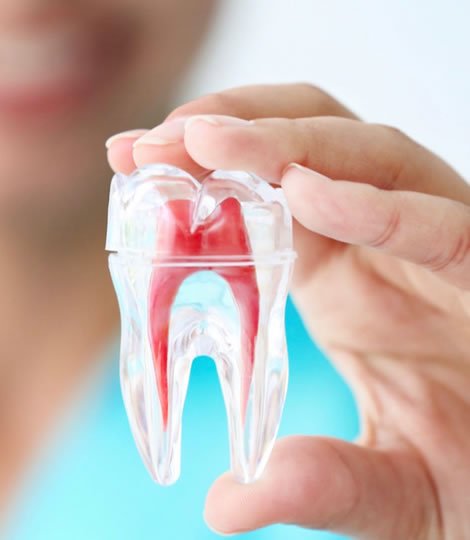Root canal therapy has a very high rate of success (>90%).

Is it really painful?
In skilled hands, it is a non-painful procedure…. contrary to current urban myths!!
We take pride at Kawana Dental in reversing those myths and painlessly changing a diseased tooth surrounded by unhealthy bone into health.
Endodontic treatment on the Sunshine Coast.
Unfortunately, trauma or untreated decay can eventually lead to the death of the inner pulp or “nerve” of the tooth.
This in turn can lead to an abscess, or pain, requiring either extraction or endodontic/root canal treatment .
Sometimes a diseased (“non-vital”) tooth doesn’t show symptoms for years, while spreading pus and bacteria into the surrounding bone, with obvious effect on general health. A digital OPG X-ray is invaluable to detect this problem.
Modern root canal therapy has a greater than 90% rate of success, and involves removing the diseased tissue in the root canals, thus halting the spread of infection.
Causes of infection or inflammation to the pulp.
Infection or inflammation of the pulp can be caused by various reasons:
- Repeated dental work to the tooth in question
- Breakdown of a (restoration) filling or crown
- A deep cavity / restoration
- Trauma / injury
- Gum disease
- Crack or chip in the tooth
- Extreme wear
Symptoms.
Symptoms may include pain, sensitivity to hot or cold, discolouration, swelling or pain in the gums or surrounding tooth.
If the pulp cannot repair itself, it will become inflamed. If it is not treated, it will die and become infected. Root canal treatment is then needed to save the tooth.
To improve the chances of success, root canal treatment should start as soon as possible. All root canals in the affected tooth must be treated. The front teeth (incisors), and premolars (bicuspids) typically have one or two root canals, and molars typically have 3 or 4 canals, and occasionally more. These canals can be very fine, calcified and difficult to find and negotiate.
If the pulp of the tooth is not treated quickly, severe pain and abscesses (infections at the ends of the roots) can occur. If an abscess is left untreated, infection can damage the bone surrounding the root. If the tooth does not have endodontic treatment, it will have to be removed.
Procedure.
Up to 3 visits are usually needed.
Although pain will be completely gone after the first visit, it is essential to finish the job as bacteria will re-colonise and further infect the canals. If a severe abscess has formed at the root tip, oral antibiotics may be needed to treat the infection.
Visit 1…..During the first visit, a small hole is drilled through the top of the tooth and into the inner chamber where the tooth decay is. Diseased tissue is removed, the inner chamber is cleansed, measured and disinfected, and the canals reshaped.
Visit 2….. More of the same as above especially if it is a molar (back tooth). X-rays will need to be taken during these three visits to establish root lengths.
Visti 3….. The cleansed chamber and canals are filled on the final visit with an inert material and sealed. Sometimes a post is cemented into a canal, with a filling placed on top to finalise the seal. If this tooth is fragile as often the case, it is recommended to have a crown, usually 6-12 months following treatment when success is established and new healthy bone has replaced the diseased bone at the end of the roots.




